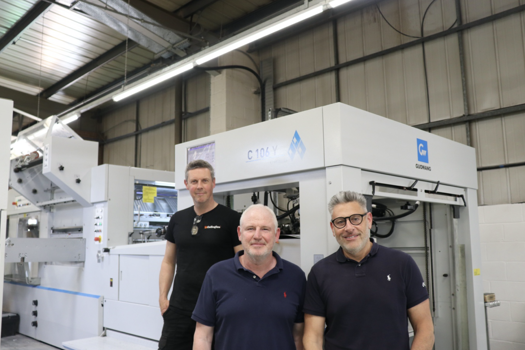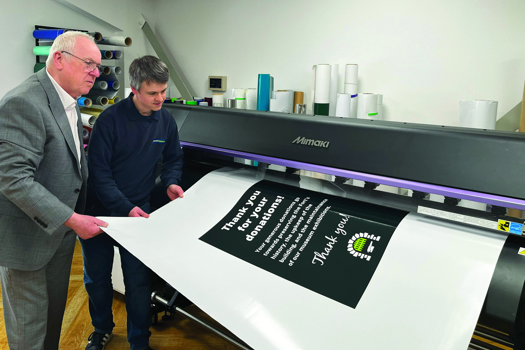The most obvious of these is the ‘Quick Response’ or QR code. This has been around since 1994 when it was developed by the Japanese company Denso Wave to track car parts. Essentially it’s a matrix barcode, sometimes referred to as a 2D barcode. Whereas standard or linear barcodes, which are based on Morse code, can hold numbers and letters, the matrix barcode can also contain additional information, such as a website address. It can be read more quickly than a basic barcode as it can be read from various angles and distances. Crucially, most smartphones can recognise these codes and automatically open an embedded link without requiring a dedicated app or any further actions from the user.
QR codes can be used on advertising posters, catalogues, magazine pages and packaging. QR codes are everywhere now, from pubs and restaurants to shops and train stations, driven by the pandemic in an effort to promote more self-service and less human interaction to limit the spread of the virus. As a result, just about anyone can now recognise a QR code and knows that they can access further information on a product, or an opportunity to buy that product, simply by pointing their camera phone at the QR code.
They are also cheap to create as most professional design programs can now generate QR codes and they can be easily printed on to most substrates without requiring special inks or even particularly high resolution printing.
There are several variations on the barcode theme, such as the Shotcode, which is a circular code that represents up to 40 bits of data. It’s a very lightweight code that can connect to a URL via a server and is mostly used as a way to track products through the supply chain. The nearest alternative is NFC or Near Field Communication, which is based on RFID radio frequency identification. This is more secure than QR codes and has been used for making contactless payments in places such as the London Underground. Thanks to this security aspect, NFC tags are also widely used to authenticate products and packaging. As with QR codes, they can be used to take users to web pages with additional information on products, or to let users reorder products.
Again, most smartphones can read NFC tags and the public is used to using them. NFC tags do not require any power source, and are easily printed, for example, as a label that can be permanently stuck onto a product. However, they are more expensive to produce than a QR code.
Image matching
Phuzion Media has developed yet another approach that has found some success with magazine and newspaper publishers, such as DMGT’s Mail Metro Media, which used it to add a shoppable element to its You Magazine, which is included within the Mail on Sunday.
Grant Woodthorpe, executive director for investment at Mail Metro Media explains: “This is a really interesting development in print technology and we’re very excited that You Magazine is the first newspaper magazine to bring it to market.
“Featuring 150 products on average per issue, You has an extensive track record of recommending items to readers that go on to sell out almost immediately after publication, and with Phuzion Media’s technology we can now keep those readers within the You ecosystem, directing them to the product pages of our advertisers, or onto You’s social pages, instead of passing them over to Google.
“Above all, we can now provide a seamless shopping experience for You’s loyal audience.”
The process works equally well for catalogues and has been used for this year’s Argos Christmas Shopping Guide. The technology relies on recognising the images that are already contained in the page layout rather than adding additional elements, as Harbir Guram, one of Phuzion Media’s directors, explains: “You don’t want high-end publications to have QR codes plastered across them, so we make no changes to the print. There’s nothing that we need to do from an aesthetic point of view that would make it look less fashionable which is why it appeals to brands’ creative directors.”
However, this approach does require users to scan one QR code or type in a web address to get the process started. This opens a Progressive Web Page, or PWP, essentially a browser-based app that accesses the camera on the user’s smartphone.
“So, for example with Argos, you onboard yourself by scanning a QR code,” Guram explains, “and then essentially you’re just taking photos of anything that you are looking at, to find out more information about or to purchase. And because we are now in this PWP world we can also track the products that you are purchasing, the pages that you scan, and potentially, if the customer grants us access, even the location where they have scanned that image.”
So, users take photos of the pictures in the magazine, which could be advertising or editorial images, but instead of the images being saved to the phone’s Camera Roll, the PWP intercepts them and matches them against a database with all the images from the publication. Guram explains: “We have preloaded what a particular photo looks like so when they take a photo of it we are matching against that particular image. We have a match percentage against the images and even on an image. Even with a low percentage match rate we are still managing to find the correct image. We have images with glare, with half the image on it, and it can still find it. So you don’t need to have a crisp environment with perfect light. And our technology works on all types of handset, on my old iPhone, on smartphones, feature phones, so we handle just about anything that’s out in the marketplace right now.”
Multiple uses
Guram says that Phuzion’s technology has a number of applications: “We have worked with magazines and newspapers where it’s more lifestyle. It could be fashion or just editorial information where that information is a bit more enhanced. So you might get behind the scenes footage or an extended version of the article. Or if you had a story on a new movie then your photo could take you to a trailer that you could watch for that movie.
“In a retail setting it’s usually you take a photo of the image that you are looking to purchase and it goes to the web page where you can purchase the item.”
He cites a number of other potential applications, such as a holiday brochure, where the images take you directly to rich content about the holiday location, or a brochure for new homes that could link to a website to offer a virtual tour, or university prospectuses, which could offer more information on the courses or a tour around the campus.
An individual image could have multiple links. So, for example, a picture of a man wearing trousers, shirt, tie and hat, could take users to a product selector page which would split out each item. Guram notes: “From a retailer’s point of view, that one image has opened the door to users buying four items or more.” Typically these would all come from the same retailer but he says that the system could link customers to multiple retailers for the different items.
Many publications will have both a print and a digital version but Phuzion Media is only involved with the printed version. Guram explains: “We don’t handle websites. Most retailers would already have the digital estate already done. This is how we invigorate the print world because we know that digital has been where the focus is for a number of years now. But people can now attribute properly what sales are coming through via print and they have never been able to do that.”
He adds: “We know how many times that particular page has been scanned and how many times that then led to a sale. The retailers can track that.”
This technology also works on TV, and on electronic billboards. Guram explains: “A TV is a set of frames so we time stamp the images so that we know that, for example, a particular dress is being shown at that point and we would take the user to the right web page for that time.”
Clearly, there’s a place for this type of image recognition, particularly in image-rich applications such as a catalogue, where lots of QR codes would ruin the design. Equally QR codes do have widespread recognition with the public, while NFC tags offer a more secure, higher value option.
All of these technologies have the power to add value to printed items by incorporating an interactive element through the reader’s phone. Given that most of those phones will also be connected directly to a payment system, that opens up an opportunity to directly monetise print, which has been limited to digital content up until now. All in all, a real fillip for the power of print.










